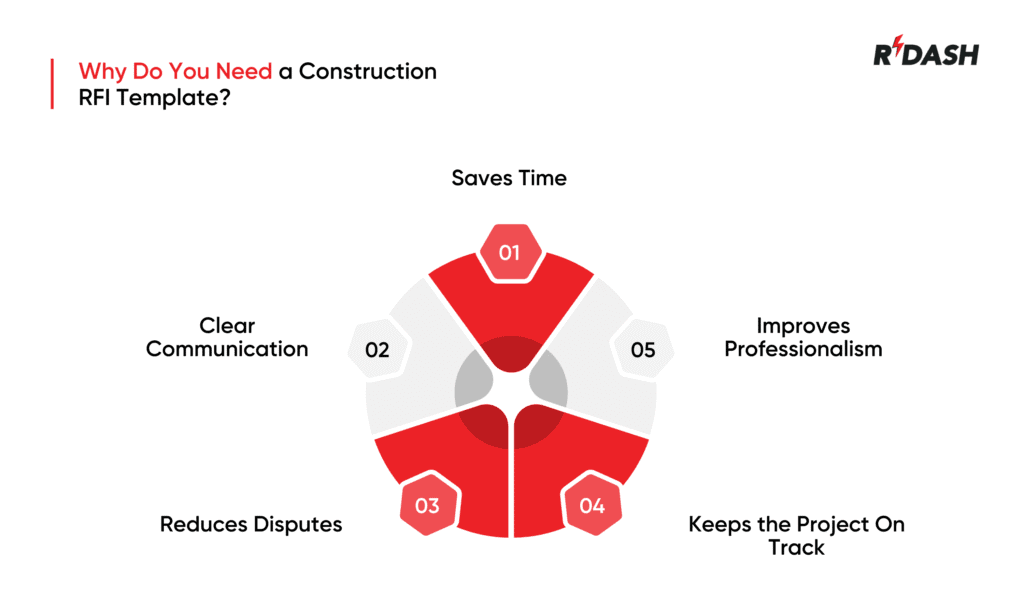What Is a Construction RFI?
In construction, an RFI stands for “Request for Information.” It is a formal way for contractors, subcontractors, or project teams to ask questions when something on the plan, drawing, or contract is unclear.
Construction projects involve many moving parts – designs, contracts, site conditions, and different teams. Sometimes, information in the plans is missing, unclear, or conflicts with other details. An RFI helps clear up these issues before they turn into bigger problems on-site.
For example, if a contractor notices that a drawing shows a wall detail that doesn’t match the specifications, they would submit an RFI to the architect or engineer for clarification. This keeps work from slowing down and avoids costly mistakes or rework.
In short, an RFI is a simple but powerful tool that keeps everyone on the same page and ensures the work meets the project’s requirements.
Why Do You Need a Construction RFI Template?
Using a construction RFI template helps you keep this process clear and organized. Here’s why it matters:

1. Saves Time:
A ready-made template means your team doesn’t have to start from scratch every time they need to ask a question. It speeds up the process and keeps projects moving.
2. Ensures Clear Communication:
A standard template includes all the important details, such as the RFI number, project name, who is asking the question, what the question is, and who should respond. This helps avoid misunderstandings.
3. Reduces Disputes:
When you keep a record of every RFI and its answer, you have proof if there are disagreements later. A clear paper trail protects both the contractor and the client.
4. Keeps the Project On Track:
Delays can happen when people wait too long for answers. A good RFI template helps track deadlines and makes it easy to follow up, so teams can keep working without unnecessary stops.
5. Improves Professionalism:
Using a clear and consistent format shows that your company is organized and professional. It gives clients and consultants confidence that you take quality seriously.
When to Use an RFI in Construction
Knowing when to submit a construction RFI is just as important as having one ready to use. RFIs help clear up confusion before it turns into costly mistakes. Below are some typical situations when using an RFI makes sense:
Potential Communication Solutions:
Construction projects often involve many teams – designers, contractors, subcontractors, and clients. If there’s any confusion about what’s expected, an RFI can help clarify details. For example, if the drawing shows dimensions different from the written specs, you should submit an RFI to get confirmation.
Preparing an Estimate:
Sometimes, project details are not fully clear during the estimation stage. If you spot missing information while preparing your cost estimate, sending an RFI can help you get accurate details to avoid surprises later.
Questions During Bidding:
During the bidding process, contractors may find gaps or unclear parts in the plans or scope of work. An RFI lets you ask questions early, so you can submit a clear and fair bid.
Potential Issues & Change Orders:
When work is underway, unexpected problems can arise — like site conditions that differ from the plan, or design details that don’t work in reality. An RFI can be used to ask how to handle these issues and to get approval for changes. Keeping detailed records of these questions can help track change orders and prevent disagreements down the line.
What to Include in an RFI
An effective RFI should be clear, thorough, and simple for the receiver to respond to. Based on the provided template, here are the key parts you should include when preparing a construction RFI:
- RFI Number: Give every RFI its own unique number so you can track it easily
- Submitted To: Include the name, title, and company of the person or team you are sending the RFI to.
- Date: Include the date you created and sent the RFI.
- Needed By: State when you need the response so that work stays on schedule.
- Submitted By: Write your name, title, and company so the recipient knows who is requesting the information.
- Project Name: Include the full project name to avoid any mix-ups.
- Project Number: Add the official project number if one is assigned.
- RFI Description: Clearly describe the question or information you need. Be specific so there is no confusion about what you’re asking.
- Attachments: Add any supporting documents, drawings, or photos that help explain the question.
- Response Section: Leave space for the person responding to provide their answer, along with their name, title, company, and the date they respond.
Who Is This Construction RFI Template For?
This construction RFI template is useful for anyone who needs to ask for clear information during a project. It can be used by general contractors, subcontractors, project managers, site engineers, or even clients.
Whether you’re bidding on a job, clarifying details during planning, or solving problems during construction, this template helps you stay organized and get answers quickly. It’s especially helpful for teams that handle large or complex projects where clear communication is key to staying on schedule and within budget.
FAQs
What is an RFI used for in construction?
An RFI is used to ask clear questions when there is missing, unclear, or conflicting information in the project plans or documents.
Who usually submits a construction RFI?
Contractors, subcontractors, or project managers often submit RFIs to architects, engineers, or clients for clarification.
How does an RFI template help?
A template saves time, keeps questions clear, and ensures you don’t forget any important details. It also helps track answers and keeps records in one place.
When should you use an RFI?
Use a construction RFI anytime you need to clarify details before moving forward – during bidding, estimating, or while work is in progress.
Is an RFI legally important?
Yes. A well-documented construction RFI can help prevent disputes by providing a written record of questions and answers.







